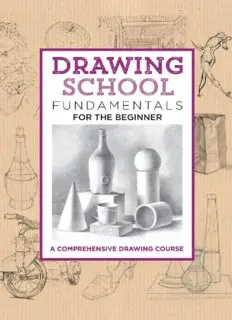
Drawing School: Fundamentals for the Beginner: A Comprehensive Drawing Course PDF
Preview Drawing School: Fundamentals for the Beginner: A Comprehensive Drawing Course
DRAWING SCHOOL FUNDAMENTALS FOR THE BEGINNER A COMPREHENSIVE DRAWING COURSE TABLE OF CONTENTS Introduction Process & Procedure Getting Started Gesture & Contour Line Drawing Learning to “See” Materials How We See & Interpret Proportion & Size Relationships Drawing Circles in Perspective Ellipses: Foreshortened Circles Perspective & the Picture Plane Part I: Perspective Part II: The Picture Plane & the XY Grid Composition Elements of Composition Principles of Composition Graphite Tonal Application Value & Light Logic How to Construct a Grid Ink Line & Tone Application Ink Charcoal Cast Drawing Additional Subject Matter Color Colored Pencil Pastel Linear Perspective Principles of Perspective Inclined Planes Aerial Perspective About the Author Introduction The ideas, concepts, and techniques in this book are based on an academic model of drawing instruction developed over the last 500 years, first taught in Europe and now worldwide. These traditional principles are alive and well wherever there is a desire to impart formal fundamental and foundational instruction in realistic, accurate artistic interpretation. This book seeks to impart to the serious, but beginning, drawing student a solid foundation that leads to the creation of artwork that combines strong draftsmanship, spatial comprehension, By Joanna and an overall energetic drawing STUDENT DRAWING Mendoza. experience. The most important aspects of successful drawing are sensitivity, focus, and passion. We are all born with the ability to create; in some children this ability is nurtured, while in others it may be repressed. As adults, we still have the ability to “tap into” our creative side, but it takes practice, patience, and guidance. Sensitivity Sensitivity in drawing refers to the handling of tools, as well as the ability to use visual sense to isolate the structure, organization, and mood of a subject. By manipulating the pressure of a drawing tool on paper, the artist can create multitudes of variable line weights: long lines; short, choppy strokes; bold calligraphic marks; and nuanced, subtle tonalities. This is called “mark-making,” and most of us have been doing it since before we could talk or walk. With direction, been doing it since before we could talk or walk. With direction, mark-making can be refined to the point where recognizable subject matter can be created. But it is important to note that all marks are not created equal! One of the most important attributes of a successful drawing is a sensitive application of varied line weight. Focus In drawing, focus refers to the ability to concentrate on and develop a clear image of the subject. In this book, the emphasis is on drawing a realistic, or representational, interpretation of the subject from observation. It is about attempting to depict a three-dimensional form on a two-dimensional surface. This is a visual alchemy that artists have struggled to achieve since the days of the first cave paintings. Focus is an essential skill that can be achieved with patience, practice, and the right environment. For some, it is the right combination of silence and/or background music that can help create this focused environment. Most importantly, try to clear your mind of clutter and negative thoughts, and avoid undue visual or aural distractions. Passion Passion in drawing, as in life, is the desire for something meaningful that can fulfill, entertain, heal, and ultimately satisfy the creative impulse. You can attain sensitivity and focus, but without the third leg of the stool—passion—you won’t have the desire to draw all the time. And that is what makes a successful artist—drawing tirelessly, constantly, and happily, over and over again. Getting Started In this book, I will take you through a journey of many steps, some easy and some challenging, as we continue along a path that will establish a strong foundation for the fundamentals of drawing. It is my goal to inform, motivate, and inspire you every step of the way along this new creative journey. PROCESS & PROCEDURE In this initial chapter, we will explore the arrangement of the drawing surface for maximum effectiveness, how holding a pencil can make a difference in the way a drawing looks, how making marks on a drawing surface can represent a dimensional reality, and how to successfully build a drawing from the understanding and use of a few key fundamental steps. Remember: A long journey begins with small steps. Getting Started Drawing & Viewing Arrangement The ideal way to see a subject and the drawing surface simultaneously is to elevate the drawing surface as vertically as possible, while maintaining a comfortable and accessible drawing position. The artist’s eyes should be the only things that move, back and forth or up and down, from the subject to the paper. The more a drawing surface is angled away from the artist’s line of sight, the less the artist will be able to comfortably view the subject. Working at an easel is an advantageous position for a variety of reasons. Most importantly, the less the artist has to move his or her head the better.
